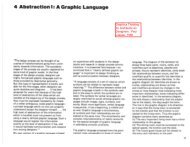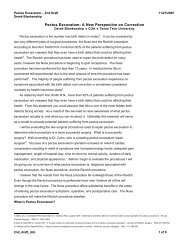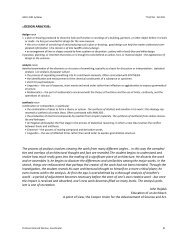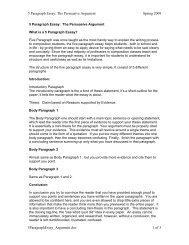The Eyes of the Skin
The Eyes of the Skin
The Eyes of the Skin
Create successful ePaper yourself
Turn your PDF publications into a flip-book with our unique Google optimized e-Paper software.
..-<strong>the</strong> world, <strong>the</strong> arrangement<strong>of</strong> his colours must carry with it this indivisiblewhole, or else his picture will only hint at things and will not give<strong>the</strong>m in <strong>the</strong> imperious unity, <strong>the</strong> presence, <strong>the</strong> insurpassable plenitudewhich is for us <strong>the</strong> definition <strong>of</strong> <strong>the</strong> real.90In developing fur<strong>the</strong>r Goe<strong>the</strong>'sidea that a work <strong>of</strong> art must be 'Iifeenhancing',9lBernard Berenson suggested that when experiencing anartistic work, we imagine a genuine physical encounter through 'ideatedsensations'. <strong>The</strong> most important <strong>of</strong> <strong>the</strong>se he called 'tactile values'.92 Inhis view, <strong>the</strong> work <strong>of</strong> au<strong>the</strong>nticart stimulates our ideated sensations <strong>of</strong>touch, and this stimulation is life-enhancing. Indeed, we do feel <strong>the</strong>warmth <strong>of</strong> <strong>the</strong> water in <strong>the</strong> bathtub in Pierre Bonnard's paintings <strong>of</strong>bathing nudes and <strong>the</strong> moist air <strong>of</strong> Turner's landscapes, and we can sense<strong>the</strong> heat <strong>of</strong> <strong>the</strong> sun and <strong>the</strong> cool breeze in Matisse's paintings <strong>of</strong> windowsopen to a view <strong>of</strong> <strong>the</strong> sea.In <strong>the</strong> same way, an architecturalwork generates an indivisible complex<strong>of</strong> impressions. <strong>The</strong> live encounter with Frank Lloyd Wright'sFallingwater weaves <strong>the</strong> surrounding forest, <strong>the</strong> volumes, surfaces, texturesand colours <strong>of</strong> <strong>the</strong> house, and even <strong>the</strong> smells <strong>of</strong> <strong>the</strong> forest and <strong>the</strong>sounds <strong>of</strong> <strong>the</strong> river, into a uniquely full experience. An architecturalworkis not experienced as a collection <strong>of</strong> isolated visual pictures, but in its fullyembodied material and spiritual presence. A work <strong>of</strong> architecture incorporatesand infuses both physical and mental structures. <strong>The</strong> visualfrontality <strong>of</strong> <strong>the</strong> architectural drawing is lost in <strong>the</strong> real experience <strong>of</strong>architecture. Good architecture <strong>of</strong>fers shapes and surfaces moulded for<strong>the</strong> pleasurable touch <strong>of</strong> <strong>the</strong> eye. 'Contour and pr<strong>of</strong>ile (modenature) are<strong>the</strong> touchstone <strong>of</strong> <strong>the</strong> architect,' as Le Corbusier put it, revealing a tactileingredient in his o<strong>the</strong>rwise ocular understanding <strong>of</strong> architecture.93Images <strong>of</strong> one sensory realm feed fur<strong>the</strong>r imagery in ano<strong>the</strong>r modality.Images <strong>of</strong> presence give rise to images <strong>of</strong> memory, imagination anddream. '[TJhe chief benefit <strong>of</strong> <strong>the</strong> house [is that] <strong>the</strong> house shelters daydreaming,<strong>the</strong> house protects <strong>the</strong> dreamer, <strong>the</strong> house allows one to dreamin peace,' writes Bachelard.9" But even more, an architectural spaceframes, halts, streng<strong>the</strong>ns and focuses our thoughts, and prevents <strong>the</strong>mfrom getting lost. \Ve can dream and sense our being outdoors, but weneed <strong>the</strong> architectural geometry <strong>of</strong> a room to think clearly. <strong>The</strong> geometry<strong>of</strong> thought echoes <strong>the</strong> geometry <strong>of</strong> <strong>the</strong> room.In <strong>The</strong> Book if 'Tea,Kakuzo Okakura gives a subtle description <strong>of</strong> <strong>the</strong>multi-sensory imagery evoked by <strong>the</strong> simple situation <strong>of</strong> <strong>the</strong> tea ceremony:'Quiet reigns with nothing to break <strong>the</strong> silence save <strong>the</strong> note <strong>of</strong><strong>the</strong> boiling water in <strong>the</strong> iron kettle. <strong>The</strong> kettle sings well, for pieces <strong>of</strong> ironare so arranged in <strong>the</strong> bottom as to produce a peculiar melody in whichone may hear <strong>the</strong> echoes <strong>of</strong> a cataract muf!1ed by clouds, <strong>of</strong> a distantsea breaking among <strong>the</strong> rocks, a rainstorm sweeping through a bambo<strong>of</strong>orest, or <strong>of</strong> <strong>the</strong> soughing <strong>of</strong> pines on some faraway hill.'95 In Okakura'sdescription <strong>the</strong> present and <strong>the</strong> absent, <strong>the</strong> near and <strong>the</strong> distant, <strong>the</strong>sensed and <strong>the</strong> imagined fuse toge<strong>the</strong>r. <strong>The</strong> body is not a mere physicalentity; it is enriched by both memory and dream, past and future.Edward S Casey even argues that our capacity <strong>of</strong> memory would beimpossible without a body memory.90 <strong>The</strong> world is reflected in <strong>the</strong> body,and <strong>the</strong> body is projected onto <strong>the</strong> world. We remember through ourbodies as much as through our nervous system and brain.<strong>The</strong> senses not only mediate information for <strong>the</strong> judgement <strong>of</strong> <strong>the</strong>intellect; <strong>the</strong>y are also a means <strong>of</strong> igniting <strong>the</strong> imagination and <strong>of</strong> articulatingsensory thought. Each form <strong>of</strong> art elaborates metaphysical andexistential thought through its characteristic medium and sensoryengagement. 'Any <strong>the</strong>ory <strong>of</strong> painting is a metaphysics,' in MerleauPonty's view,97 but this statement might also be extended to <strong>the</strong> actualmaking <strong>of</strong> art, for every painting is itself based on implicit assumptionsabout <strong>the</strong> essence <strong>of</strong> <strong>the</strong> world. '<strong>The</strong> painter "takes his body with him",says [Paul] Valery. Indeed we cannot imagine how a mind could paint,'Merleau-Pontyargues.9RIt is similarly inconceivable that we could think <strong>of</strong> purely cerebralarchitecture that would not be a projection <strong>of</strong> <strong>the</strong> human body and itsmovement through space. <strong>The</strong> art <strong>of</strong> architecture is also engaged with44THE EYES OFTHE SKINPART 2 45••••
















